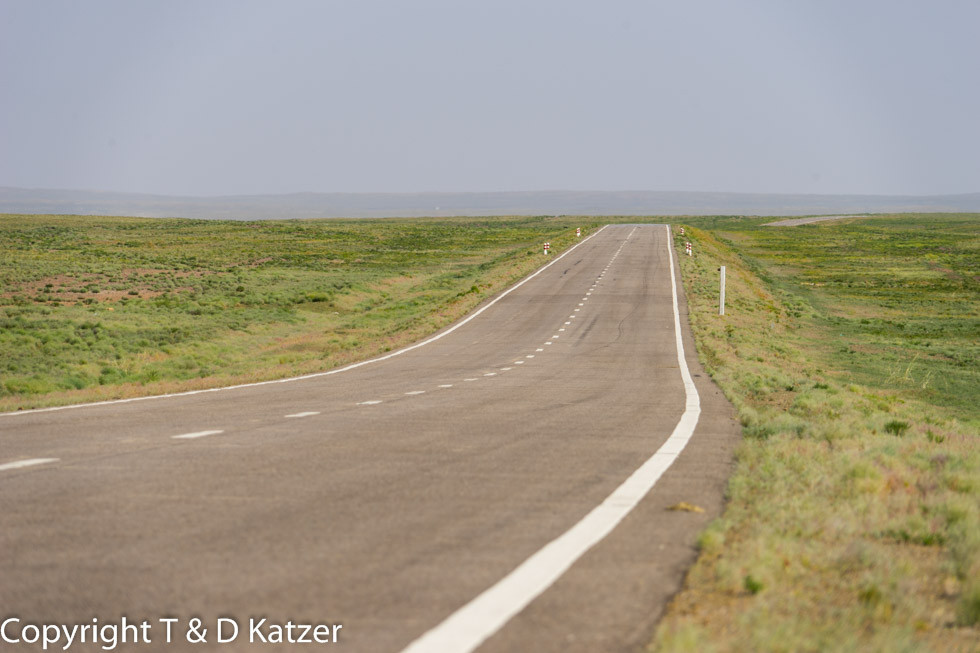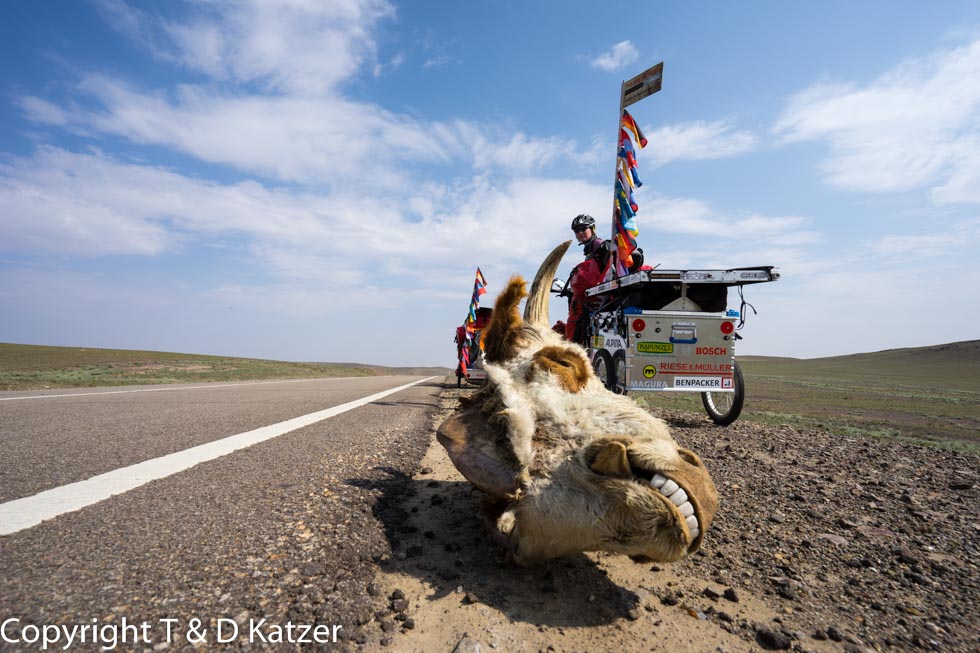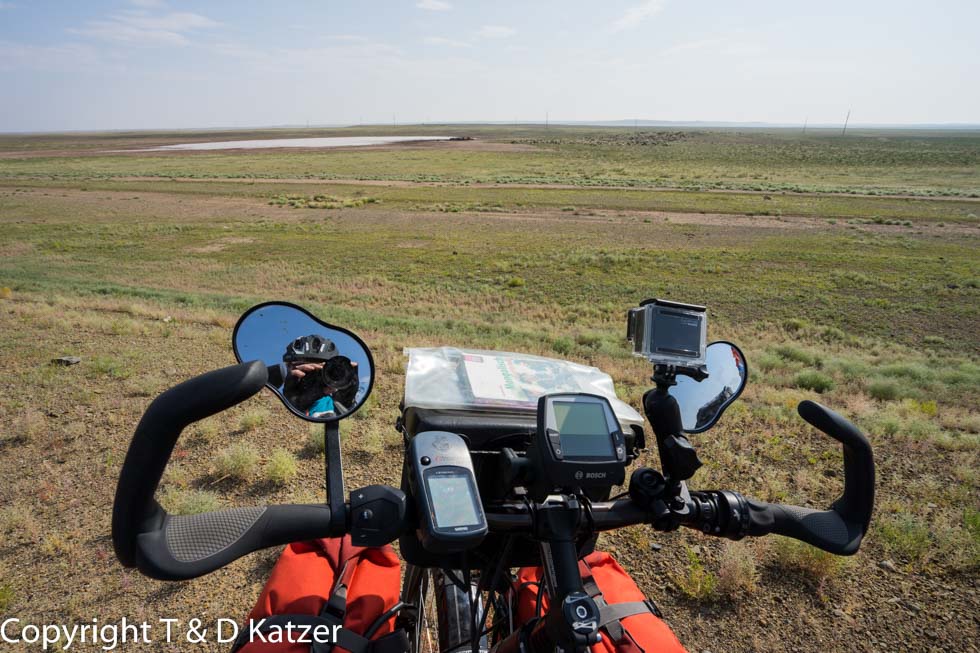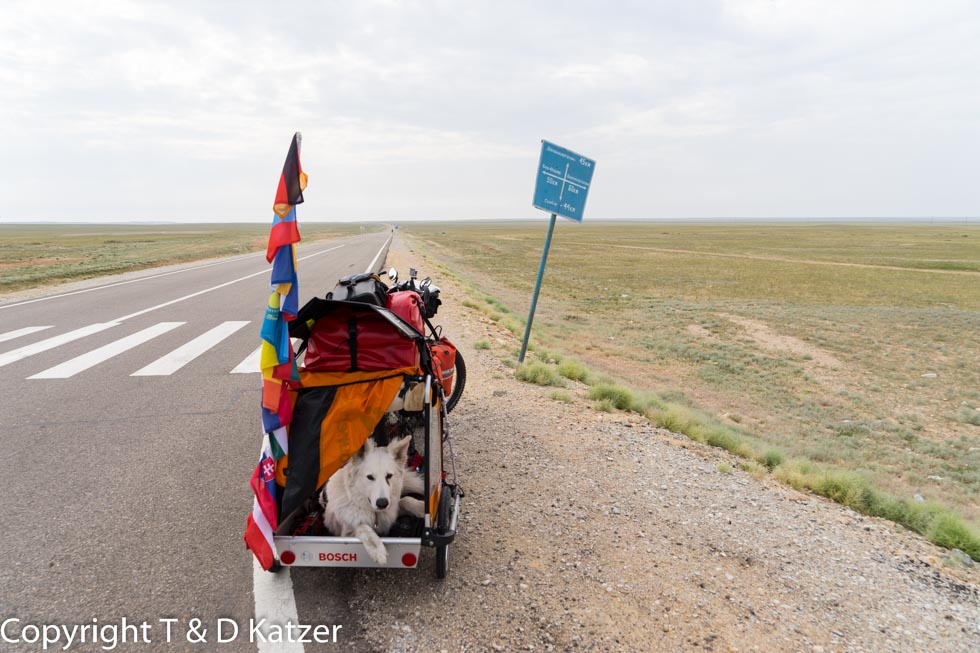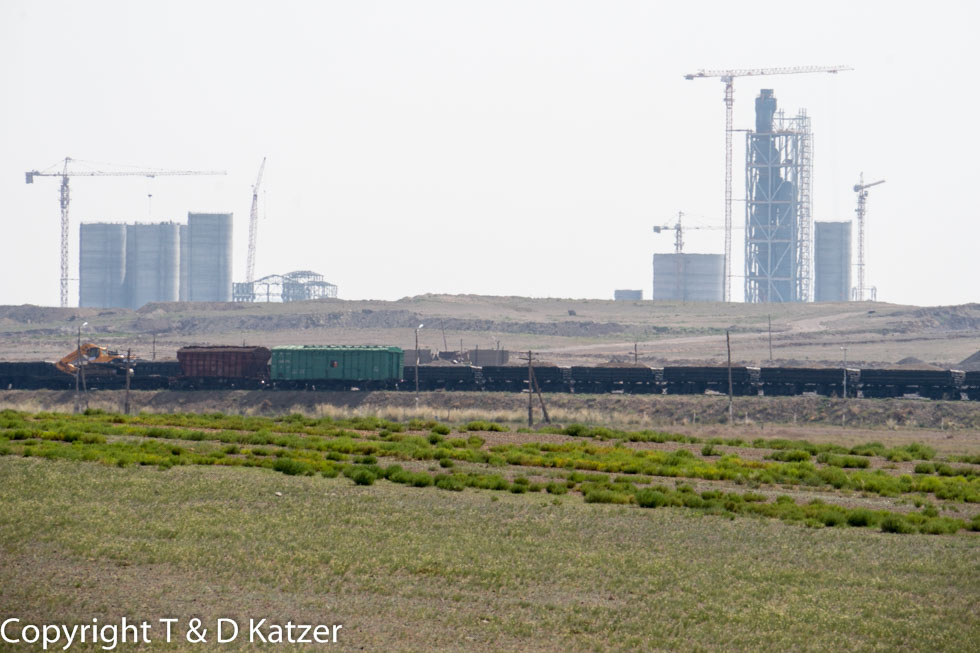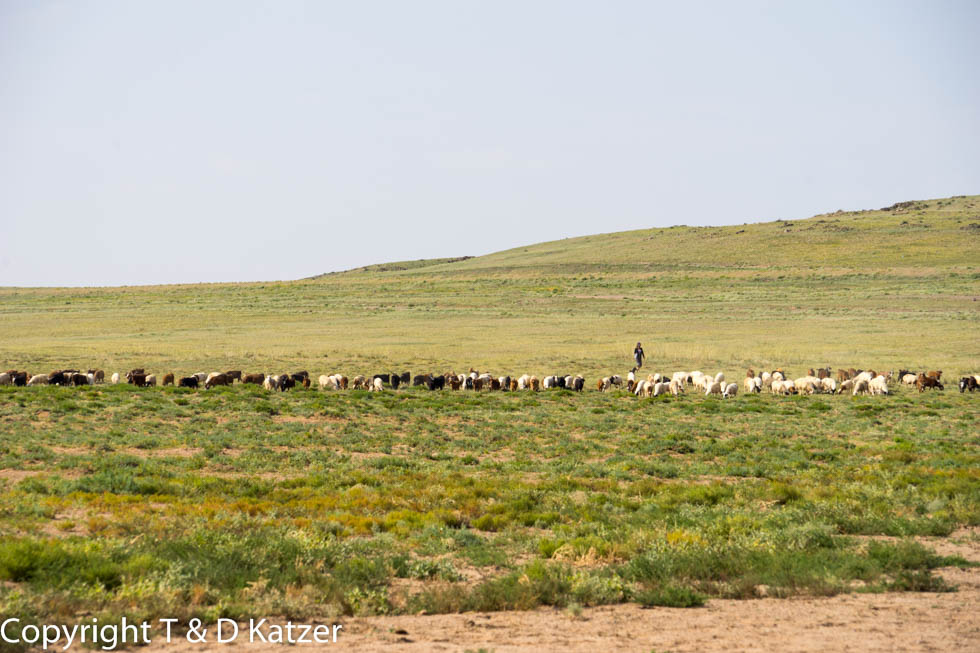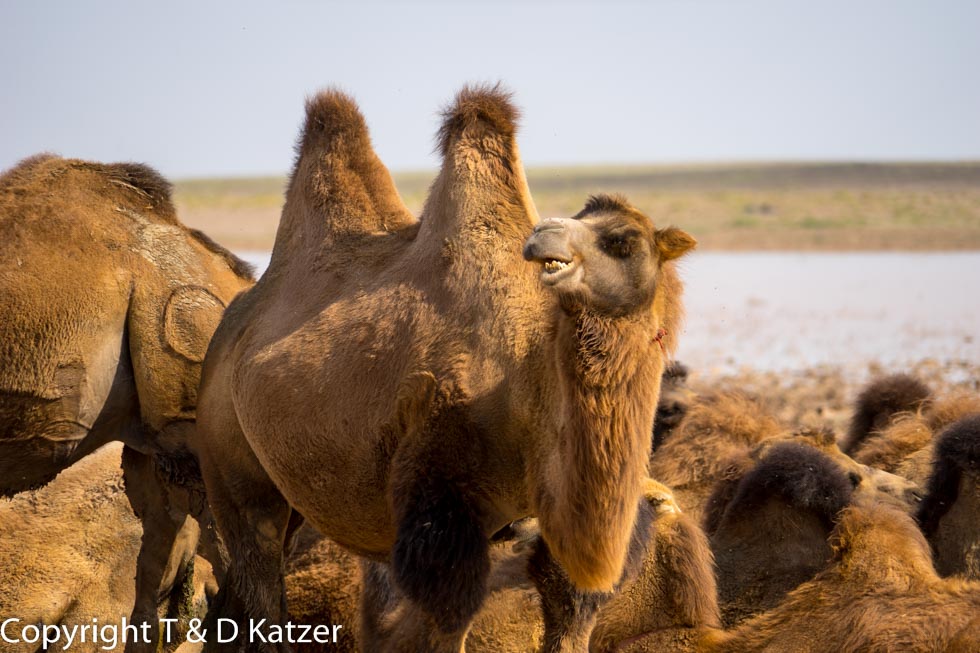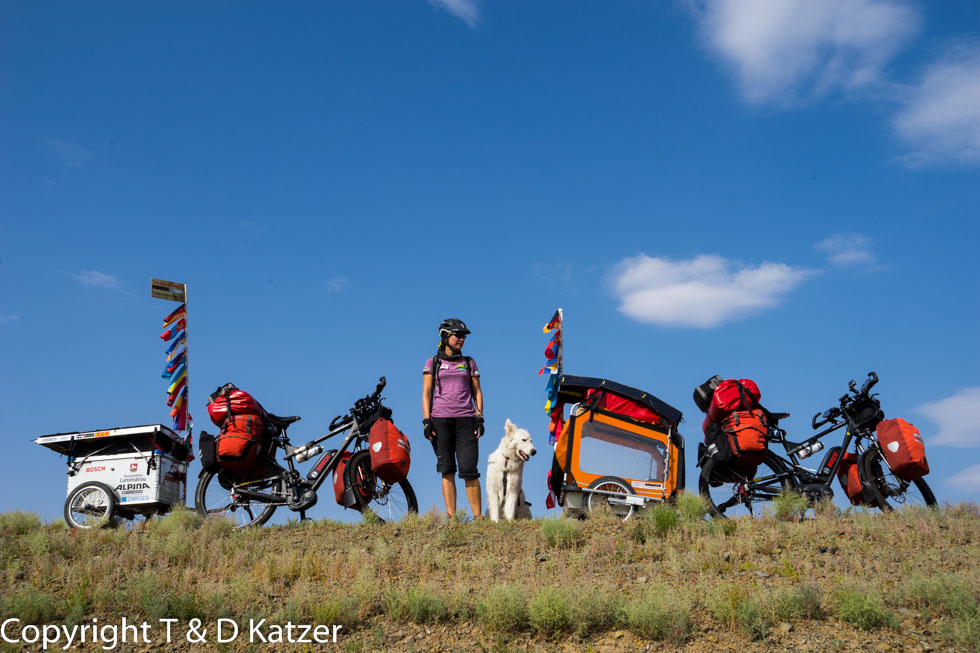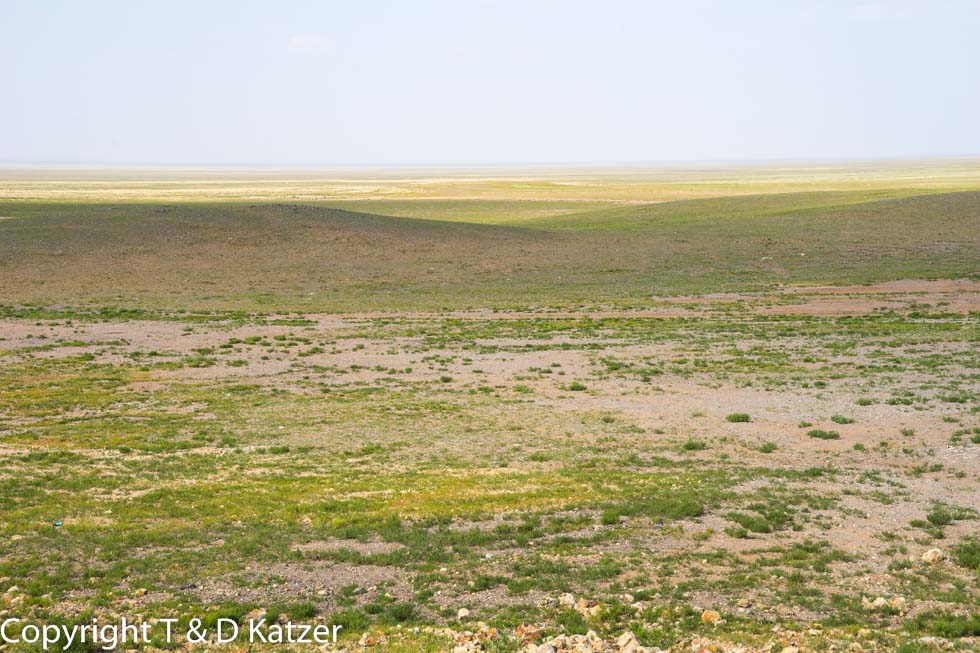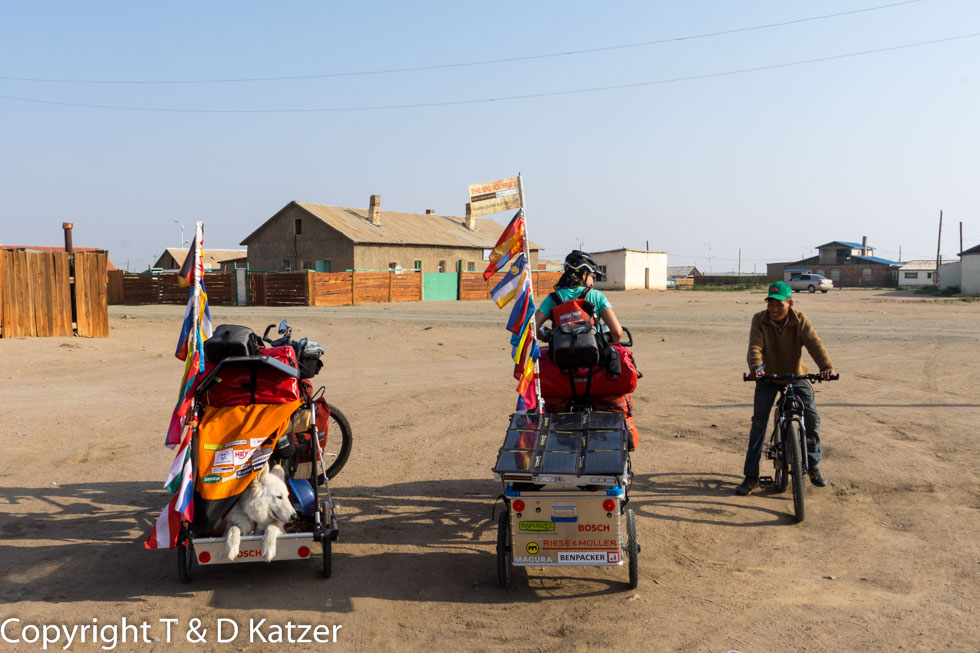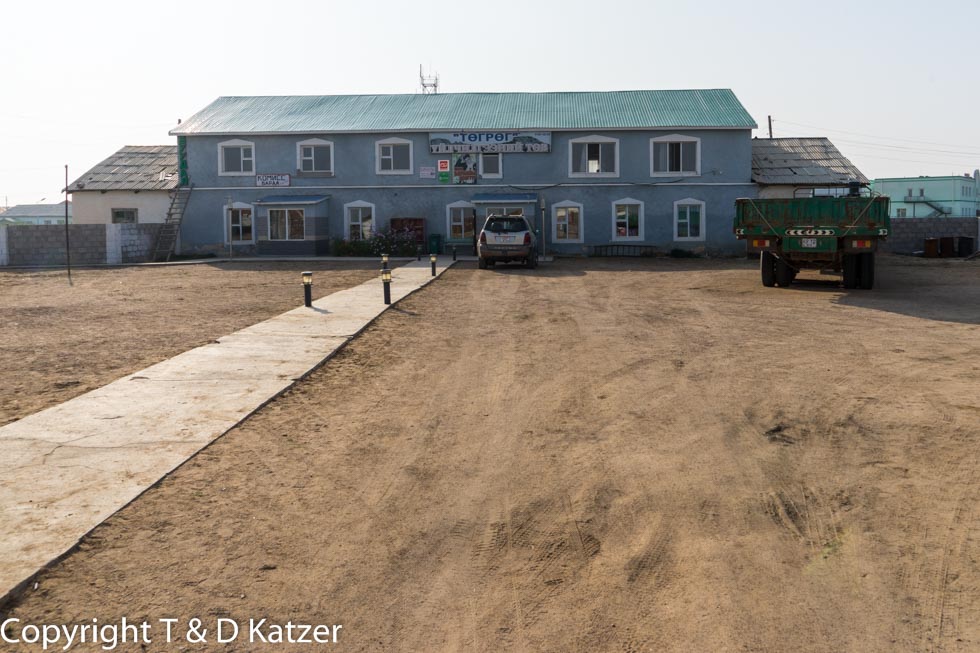
Dreaded wind in the Gobi Desert
N 45°47'56.9'' E 109°18'55.5''
Date:
01.09.2015
Day: 65
Country:
Mongolia
Location:
Khar-Airag
Latitude N:
45°47’56.9”
Longitude E:
109°18’55.5”
Kilometers per day:
108 km
Total kilometers:
8,909 km
As the crow flies:
94 km
Aver. Sib.
25.0 km/h
Maximum speed
43 km/h
Travel time:
4:19 hrs.
Soil condition:
Asphalt very good
Maximum height:
1.200 m
Total altitude
3,546 m
Altitude meters for the day
16 m
Sunrise:
07:01 a.m.
Sunset:
8:24 pm
Temperature day max:
28 °C
Departure:
09:20 am
Arrival time:
17:00
(Photos of the diary entry can be found at the end of the text).
Although we still don’t feel fit, we want to keep going. Because of our visa, we have to be in China in two weeks, otherwise it loses its validity. There are only about 500 km to go, but you never know what unexpected hurdles you might have to overcome. Our previous travel experience has taught us to always have a safety buffer at the border. So definitely not on the last day. It was far too difficult to get a six-month visa for China to lose it in the end because of some incident. As a result, we leave the dingy little town of Tschoir behind us. As soon as the town disappears in our rear-view mirrors, wonderful, brand-new asphalt spreads out in front of us. Just a few years ago, there were only terrible clay and sand tracks on this route. The riders used the entire valley to work their way across the potholed track in countless lanes. A catastrophe for the passengers, but also for nature, as the car tracks plowed through the steppe over a width of many kilometers. Now, lo and behold, there is unexpectedly a wonderful road without cracks and holes. This was a huge stroke of luck for us, as we fitted wide studded wheels to our superbikes especially for this dreaded section. This was the only way we would have managed the planned 50 km a day on this former field.
“Great!” I’m delighted with the fantastic surface when suddenly the dreaded Gobi wind blows towards us at around 25 km/h (wind force four). Although we have electric assistance, the headwind acts like a tough wall that resists being penetrated by us. “Imagine we didn’t have e-bikes!” I shout to Tanja. “Not a good idea!” I pant in my slipstream. The first battery is empty after 22 km. We use two batteries. “How far is it to the next charging point?” asks Tanja. “The next place marked on the map is 230 km away. I don’t know if there’s a roadside restaurant before then,” I reply, worrying that I won’t be able to load in time. “We won’t make it to that place,” Tanja says dryly. “If the wind continues to blow against us from the south, no chance. We’ll have to trust in God and hope we come across another food shed like this,” I reply, swinging onto my bike. “Something will come!” Tanja shouts. Motivated by their positive attitude, I don’t let my negative thoughts of being left in the desert without electricity drag me down.
Shortly before the second battery runs out, a poor mud house and a wooden hut appear at the side of the road. “It’s a small store,” Tanja says with a laugh. “Yes!” I shout with relief, rolling my bike over the sandy track to the hut. A few Mongolians step out of their dwellings and look towards us. “Sain bajtsgaana uu”, (Good day to several people) “Sain bajtsgaana uu”, they reply with a laugh. I put the bike on the stand and enter the tiny store to see if there is electricity. There are a few bars of melted chocolate, some boxes of cookies, nuts and snacks in a glass display case. There is vodka, water, cigarettes, washing powder and in the corner of the stuffy room a fridge is actually humming, trying in vain to cool a few sausages and wilted vegetables. I step outside again in a good mood. “There’s electricity,” I say. “Even though there are no electricity pylons to be seen for miles around?” wonders Tanja. “Maybe the cable is underground. It doesn’t matter, the main thing is that they have electricity in this deserted area.” The owner of the store generously lets us charge our batteries and even pulls the cable of her fridge out of the socket. “Tschin setgeleesee bajrlalaa”, (Thank you very much) I thank you. In return, we buy Chinese instant soups and a few bottles of drinking water from her.
The friendly woman immediately brings us a kettle where we can heat water for our soups. Because we in Germany mainly eat organic food, under normal circumstances we would never eat such a soup with flavor enhancers and chemical additives, but these are not normal circumstances here. Apart from that, you don’t get sick after eating such a ready-made soup, at least not immediately. We are very hungry and eat two portions per person. Tanja puts the spoon into the plastic bowl with a full belly and looks at me. “What?” I ask. “I’m just thinking about the fact that it’s certainly not just us.” “What do you mean?” “Well, with the spoiled food. I think many locals suffer from it too. They’re not made of steel either.” “I’m sure they get sick too. Mongolians have often told us about stomach and digestive problems. Perhaps the lack of hygiene is also the reason why the average age of this people is far lower than that of Europeans. Certainly also the large amount of vodka, the bad air in the U.B., the often inadequate medical care, but also the enormous consumption of meat and, as mentioned, the one or other spoiled food,” I ponder. “It should actually be a basic right of everyone to be able to eat enough unspoiled food,” Tanja muses. “Hm, that would be nice. There is enough food on earth to feed everyone. Distributing it fairly is certainly one of the greatest challenges of the 21st century.”
Until our batteries are full, we sit in front of the simple mud house and philosophize animatedly about life in Mongolia and the rest of our journey. Then, almost three hours later, we thank the woman once again, put the batteries back in and continue south against the hot desert wind with full power packs. “How far is it to the village?” asks Tanja “180 km.” “Too far for today.” “Not just for today. We need another store or another charging option so we don’t have to push there,” I reply. “Or the wind turns and blows us there.” “Ha, ha, ha! You really are an incredible optimist,” I laugh and am pleased with Tanja’s confidence, because I realize that negative thinking won’t get us anywhere.
The A0102 highway continues to cut through the desert steppe. Large cranes, chimneys and angular buildings appear again and again, stretching their dusty silhouettes into the sand-soaked desert sky. These are mining facilities used by international companies to extract the mineral resources of Mongolia, which is one of the ten most resource-rich countries in the world. Sometimes these mines are built not far from the Trans-Mongolian Railway, which is then used to transport the riches out of the country. Mostly, however, they are out of our sight in the middle of the desert. In the south, for example, coal and copper deposits have been discovered that are among the largest in the world. I have read that 6,000 deposits of 80 different minerals such as uranium, oil, gold, silver, fluorspar, molybdenum, zinc and diamonds have been discovered in this country so far, although only a third of the vast land has been explored. Lost in my thoughts, I look at the mounds dug out by humans, which seem unnatural in this landscape. According to media reports, open-cast mining is often carried out with the support of highly corrupt politicians without regard for losses and in disregard of approval procedures and environmental regulations. As a result, the flora and fauna suffers enormously from the waste water, the tailings and the processing plants and, as already described, is permanently damaged and destroyed. Entire rivers, such as the Ongi, have already disappeared from the map.
We cycle past large herds of horses, sheep, goats and camels and although many people say deserts are boring, I love them. On the contrary, I find this type of landscape very interesting. The beauty of a desert lies in its openness, clarity, vastness, generosity, spectacular sunrises and sunsets, often not in the rough but in the detail. Especially as a hiker, the idiosyncratic grace, the different shades, colors, animal tracks and the drawings of a blade of grass whose stalk is bent by the wind and leaves the finest paintings in the sand like a brush.
A few days ago we received an email from a reader who described it as a disadvantage to cross a country on a main road. He thinks that the landscape is unattractive and that our experiences are therefore not beautiful or uninteresting. I thought about this statement and asked myself whether there was any truth to it. As we spent a total of two years in this country and spent many months moving around and living in the most remote corners, I find it difficult to agree with this statement. The question is whether our experiences in the taiga, with the reindeer nomads, were better or more exciting than now on our e-bike expedition? I can only say that they are different. Everything else is more a question of taste and personal preference.
If you look at it closely, a landscape is beautiful, interesting and unique everywhere, whether on a main route or a side trail. It is people who drive along a road through a landscape and who wants to claim that this area is less attractive, uninteresting or boring just because there are more people on the route than elsewhere. Tanja and I have now covered 350,000 kilometers without flights, on all kinds of roads, paths, trails and off-roads. It was interesting everywhere and never comparable. It depends on the diversity of our Mother Earth, the diversity of a country, a road or a path. Clearly, on this path you can only report on the experiences that happen to you. Because you only travel to a tiny aspect of the country, it is absolutely impossible to do justice to the entire state. Anyone who, like us, has traveled intensively through the Gobi, Sinai, Taklamakan, Gipson, Tanami Simpson, Small and Great Sand Deserts of Australia has nevertheless only traveled through a fraction of the country and only knows aspects of the people who live there. Anyone traveling to Beijing, Berlin, Tokyo or Sidney does not know everything about the respective countries, but only gets a tiny insight into the lives of the city dwellers there. Even people who have grown up in a city only know areas of their own metropolis, let alone the country they live in. Even if two people take the same trip at the same time, their experiences can be completely different. One finds a lump of gold by the wayside, while the other is attacked by highwaymen. Their statements will end up being very different. To sum up, it is very interesting for us in all places, cities, streets, paths, in the center of a desert, living together with an indigenous people in the tropical jungle. During our travel life we collect the most diverse aspects, perspectives, feelings, views, have the most varied experiences, sensations, go through a hard school of knowledge, self-knowledge, experience highs and lows, are honed and rebuilt, pass through valleys and climb the highest peaks both mentally and physically. We are carried by the pulse of Mother Earth. At the end of our journey we have gained an insight into how humanity lived in the 20th and 21st centuries and although our entire being flows into it, it remains just an insight…
Thanks to good energy management, we reach the small village of Khar-Airag, which is not on my map, after 108 kilometers against the desert wind. We are all the more pleased about this, as we would only be able to travel just under 25 km on our batteries. “Haa bajna buudal?” (Where is there an inn?) I ask a gas station attendant. “Ügü, there’s no inn here,” he replies, much to our disappointment. “Let’s ask the man there,” I suggest and push my bike, with tired bones, towards the moped driver who is about to fill up. “Bi medehgüj”, (I don’t know) he slurs drunkenly. Exhausted and disillusioned, we let our Riese and Müller roll to another service station about 100 meters away from here. “You have to drive another 26 km. There’s a hotel there,” he says, apparently unaware that there will be no human settlement for the next 130 km. “And what do we do now?” asks Tanja. “Phew, I wish I knew.” “What do you think?” I try to feel inside myself and all I feel is tiredness and exhaustion. After a while, we decide to drive to the town, despite the negative comments about accommodation. “Haa bajna buudal?” (Where is there an inn?), I ask a cyclist coming towards us. “Over there,” he answers, pointing to a light blue, single-storey building. Tanja and I reply “Ih bajrlalaa” (thank you very much), full of hope that we will still have accommodation for the night. We park our bikes and ask for a room in the house. “Hüle, hüle”, (wait) we are advised to wait. After ten minutes, a car drives into the yard and dumps an entire family. They are the owners of the guest house. They very kindly offer us a nice, clean room on the second floor for 25,000 tugrik (€11.12). While the landlady and her children help Tanja carry the equipment to the second floor, the landlord and I lift our bikes and trailers into a room, which he immediately locks once they are set up there.
Exhausted but happy to have come this far today, we sit in our room and eat a few rotten tomatoes and cucumbers from the jar. It is served with white-red cheese spread, which, according to the manufacturer, keeps for 10 months. “I couldn’t find anything else in the supermarket down there,” explains Tanja. “It doesn’t matter, the main thing is that we don’t get sick again,” I reply, even though we’re still suffering from stomach ache.
As we crawl onto our freshly covered mattresses, we talk about tomorrow. “And how many more kilometers are there to the town of Saichan?” Tanja wants to know. “Around 130 km.” “Will we manage that with the batteries?” “Hm, no idea.” “We should drive in eco mode, maximum tour mode.” “That’s what I thought too. But that won’t be enough. We’ll only get there when the headwind dies down,” I think. “Maybe it will be like this. I think we’ll make it,” I hear her confident reply…
The live coverage is supported by the companies Gesat GmbH: www.gesat.com and roda computer GmbH www.roda-computer.com The satellite telephone Explorer 300 from Gesat and the rugged notebook Pegasus RP9 from Roda are the pillars of the transmission.
